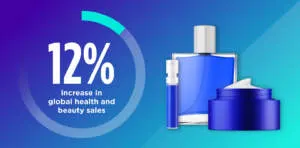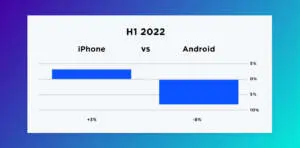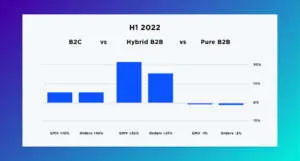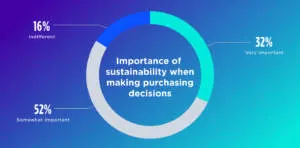Explore the
BigCommerce platform
Get a demo of our platform to see if we’re the right fit for your business.
Not ready for a demo? Start a free trial
2022 Global Ecommerce Report: Health and Beauty
Haylee Reed


2022 Global Ecommerce Report: Health and Beauty
Get The Print Version
Tired of scrolling? Download a PDF version for easier offline reading and sharing with coworkers.
A link to download the PDF will arrive in your inbox shortly.
Ecommerce may have roots all the way back to 1969, but there’s no doubt that the last two years have completely transformed the world of online shopping.
In 2022, global retail ecommerce sales are projected to surpass $5 trillion for the first time, and by 2023, digital sales are expected to reach 22% of global retail sales, compared to just 14% in 2019 — which goes to show that ecommerce is no longer a rarity, but a norm.
In the age of Amazon and a fading pandemic, there are few things you can’t buy online. Fashion apparel, electronics, digital products and even groceries are just a few of the most popular online shopping categories.
Following in the footsteps of our Global Ecommerce Report on fashion and apparel, for BigCommerce’s second industry trend report, we’ve decided to examine another shopping category that is poised for tremendous growth: health and beauty.
According to Statista, global ecommerce sales in the health and beauty category are projected to reach $449.6 billion by 2027, and Insider Intelligence forecasts U.S. cosmetics and beauty retail ecommerce sales in 2022 will be more than double those of 2019. Our data shows the health and beauty category is poised for growth if the trends of the first half of 2022 remain constant or improve.
Read on for more insights into the state of health and beauty ecommerce so far in 2022 from BigCommerce and our merchants.
Methodology
BigCommerce’s health and beauty data is sourced directly from our merchants and was pulled on August 23, 2022. All data is global and pertains to all countries where BigCommerce merchants do business, unless otherwise noted.
All comparisons are congruent comparisons between the same number of existing stores dating back to the earliest period used in the comparison. For example, a comparison between the first half (H1) of 2021 and H1 2022 would use data only from BigCommerce stores that existed in H1 2021, unless otherwise noted.
How the Health and Beauty Industry is Performing in 2022

In H1 2022, we saw a 12% increase in gross merchandise volume (GMV) for health and beauty merchants compared to H1 2021. The same growth held true for health and beauty’s orders, which saw an 11% increase between H1 2021 and H1 2022.
However, year-over-year (YoY) average order value (AOV) for the health and beauty category did not follow this same pattern, with AOV remaining relatively flat from 2021 to 2022.
Social platforms remain a dominant sales channel.
With the U.S. social ecommerce market expected to surpass $50 billion annually by 2023, it’s no surprise that social media remains a leading sales channel for health and beauty brands.
Comparing 2022 to 2021, health and beauty merchants selling on both Facebook and Instagram saw an 83% increase in H1 for YoY GMV. Looking at YoY orders, these merchants experienced an increase of 140% in H1, while YoY AOV decreased by 24%.
Mobile sales experienced slight change.

Despite a widespread shift toward mobile and social commerce, our merchant data revealed that YoY orders were down 6% in H1 2022, GMV was down 2% while AOV was up 5% compared to H1 2021.
When comparing order sources, online sales via iPhone clearly outperformed sales via Android.
Between H1 2021 and H1 2022, the health and beauty category saw a 3% increase in GMV, a 6% increase in AOV and only a 2% decrease in orders via iPhone. However, by the same measure, the health and beauty category saw an 8% decrease in GMV, a 3% increase in AOV and an 11% decrease in orders via Android.
Health and beauty brands grow in B2C and hybrid B2B.

When it came to B2C businesses, health and beauty showed significant YoY improvement. Health and beauty orders for B2C were up 10% in H1 2022, and YoY GMV numbers were also up 10%. However, YoY AOV was only up 1%.
Hybrid B2B (merchants selling both B2C and B2B) numbers were even more drastic. Health and beauty orders were up 21% in H1 2022 compared to H1 2021, GMV increased by 32% and AOV increased by 9% YoY.
Pure B2B businesses, on the other hand, didn’t show the same growth. Health and beauty merchants experienced a 1% decrease in GMV, a 2% increase in AOV and a 2% decrease in orders between H1 2021 and H1 2022.
Health and beauty outperformed overall ecommerce in AMER.
The health and beauty category significantly outperformed overall ecommerce in North America, with a 15% increase in YoY GMV in H1 2022 and a 15% increase in the total number of orders, while YoY AOV remained flat.
However, APAC and EMEA told a slightly different story.
In APAC, health and beauty merchants experienced only a 6% increase in GMV, a 9% increase in orders and a 3% decrease in AOV from H1 2021 to H1 2022. And in EMEA, the health and beauty category saw an 1% decrease in GMV, an 11% decrease in orders and an 11% increase in AOV between H1 2021 and H1 2022.
Health and Beauty Ecommerce Trends and Predictions
The numbers said it best: the health and beauty industry is definitely ahead of the curve when it comes to ecommerce.
Looking back on the first half of 2022, here are some noteworthy trends that are shaping this ecommerce category:
Social commerce helps brands meet customers where they are.
According to eMarketer, the U.S. social commerce market is projected to surpass $50 billion annually by 2023, which means that selling on social media is a must, especially for ecommerce brands. Plus, with Gen Z gaining buying power and 26% of them using social media to make purchases, this target demographic represents a significant opportunity for retailers to gain market share and boost online sales.
Instagram and Facebook lead the way in social commerce functionalities, but other social media sites are also gaining traction: YouTube, Pinterest and, most notably, TikTok.
A relatively new player to the social commerce game, but now a household name, TikTok has a unique ability to make lesser known users, brands and products go viral overnight. Equipped with ecommerce features such as analytics tools, product links and advertising options, TikTok has become a hub for businesses — especially health and beauty brands — to reach new audiences and drive more sales.
Videos with the hashtag #Makeup have been viewed over 230 billion times on the app, and #BeautyHacks (15.5 billion views) reveals the number of TikTok viewers who use the platform for advice and education. Just a quick swipe through “BeautyTok” — the segment of TikTok content dedicated to makeup and cosmetics — proves that health and beauty brands have a massive opportunity to market and sell on TikTok.
TikTok aside, we can’t talk about health and beauty marketing with talking about video.
From makeup tutorials to product reviews, visual content is a prime way to market health and beauty products, no matter the social platform you’re using.
YouTube, especially, has been a well-known platform for health and beauty influencers to promote their favorite brands and products.
Instagram and Pinterest offer reels and short-form videos, allowing brands and creators to bring their products to life.
Livestream Shopping provides an unfiltered, raw experience, allowing customers to shop in real time without having to visit a physical store.
AR and VR bridge the gap between online and offline.
As the in-person shopping experience shifts online, ecommerce brands have needed to find ways to bridge the gap between the physical and digital. How can a customer try on an eyeshadow, visualize the color of a nail polish or match a foundation to their skin tone — all from the comfort of their own home?
Purchasing any item online (especially one that’s high-cost) may seem risky enough, but purchasing a beauty or cosmetic product without physically trying it on adds a new level of uncertainty. So, for an industry as hands-on and visual as beauty, this shopping category is undoubtedly one of the strongest use cases for augmented reality (AR) and virtual reality (VR) in retail.
AR and VR works to ease this anxiety and provide shoppers with an experience that matches that of a brick-and-mortar store. From Instagram and Snapchat filters to virtual makeup try-ons, these emerging technologies give consumers the ability to interact with three-dimensionally rendered representations of products in real-time.
And in no place do we see these trends more ready to take hold than in the Metaverse.
In fact, our Global Consumer Report — which surveyed more than 4,000 online shoppers in the US, UK, Italy, France and Australia — found that almost half (46%) of respondents said they are willing to shop on the Metaverse, and of those, 51% are interested in buying both virtual and physical goods — which means the time for health and beauty brands to invest in emerging technologies is now.
Post-pandemic convenience remains top-of-mind.
As we examine the health and beauty category as it emerges from the other side of the COVID-19, we can’t deny that the effects of the pandemic are still being felt.
According to a 2021 survey by Statista, 36% of respondents indicated they ordered more drugstore and healthcare products online during the pandemic than before the pandemic, and another survey cited that the top reason for shopping online is convenience.
Needless to say, the convenience of online shopping introduced by COVID-19 isn’t going away anytime soon. But what does this mean for online retailers?
First, it means offering fast and free shipping. Think Amazon next-day delivery, pick-up in-store and real-time tracking updates.
Second, it means offering multiple alternative payment options. Digital wallets, cryptocurrency and, most notably, buy now, pay later (BNPL) have skyrocketed in popularity, as they give shoppers the flexibility to pay when and how they want. In fact, our Global Consumer Report revealed that 16% of consumers have used BNPL at checkout, and 49% of consumers who have used BNPL say it helps purchases fit into their budgets.
LARQ, a self-cleaning water bottle brand and BigCommerce merchant, experienced firsthand the advantage that comes with offering multiple payment options. With only one option for credit card checkout and two-thirds of its transactions coming through mobile, LARQ eventually launched Google Pay as an alternative payment method.
“A significant portion of our transactions have gone through Google Pay since we implemented it, which is a good indication for us that we’re offering something that customers find valuable,” said Antonio Kaleb, LARQ Ecommerce Architect, and Justin Wang, LARQ Co-Founder and CEO. “The ability to access things like Google Pay seamlessly through BigCommerce has helped boost our conversion rate by about 20% since launch.”
Lastly, convenience means creating a seamless checkout experience, using features like intuitive category navigation, one-click checkout and in-app purchases. Every additional click a customer makes is another chance for them to exit out of your page and never come back, so it’s your job to make the checkout process as quick and frictionless as possible.
Clean beauty steals the spotlight.
As Gen Z gains spending power, ecommerce brands are learning how to speak to the values of today’s shoppers. In our Global Consumer Report, when asked what brand values influence their purchase decisions, the majority of consumers ranked honesty and transparency as the most important value. And when it comes to health and beauty brands, this honesty and transparency extends to a product’s ingredients, its packaging and even the labor behind the product.
Fading are the days of popular, mass-produced cosmetics manufactured with harsh chemicals and toxins. Today’s younger consumers are paving the way for new standards of beauty — calling for sustainable, natural ingredients, minimal packaging and fair working conditions.

In fact, our consumer behavior survey found that the majority of consumers rate sustainability as either very important (32%) or somewhat important (52%) when making a purchasing decision. Plus, only 8.5% of Gen Zers stated that they were indifferent about sustainability, which means it’s even more important for brands that target a younger audience to market their sustainability efforts.
As a B Corp-certified, clean, cruelty-free skincare brand, Bliss has fully embraced the move toward clean beauty. The brand’s products are “clean, dermatologist-tested and thoughtfully formulated to minimize our environmental impact,” and the company even includes an Ingredients Glossary on its website.
Diversity and inclusion become a top priority.
But consumer brand values don’t stop at sustainability — diversity and inclusion have also become essential to maintaining customer loyalty.
Historically, the health and beauty industry has been limited in both its product selection and brand messaging when it comes to diversity and representation. But in the wake of COVID-19, the Black Lives Matter movement and growing support for the LGBTQ+ community, consumers are advocating for beauty that reflects all ages, skin tones, genders and body types. And many global beauty brands are getting on board.
But diversity and inclusion isn’t just about offering a greater range of foundation shades (even though research shows that unique color options in cosmetics have grown 7x as fast as product lines). Diversity and inclusion now means greater representation in product photography and videos, advertisements, models and even influencers on social media.
As more consumers seek out brands that align with their core values, global beauty brands that embrace the “beauty for all” movement are poised for success — while those that don’t risk missing out on a new generation of consumers.
Navigating the Future of Health and Beauty Ecommerce
With emerging technologies transforming the way consumers shop online, the health and beauty industry is in prime position to benefit from these trends.
From virtual makeup try-ons to AR filters, the future of health and beauty ecommerce is only just around the corner.
Omnichannel selling creates a connected user experience.
Ultimately, many of the most successful businesses are the ones with a strong omnichannel strategy — one that weaves together all business channels, online and offline, to create a consistent, engaging customer experience.
In fact, marketing across three or more channels earns 250% higher engagement.
With online marketplaces such as Amazon and Walmart, social media channels like Instagram and Facebook and search engines like Google, there are hundreds of ways to reach customers aside from a traditional online store.
But the key to omnichannel selling is to provide a cohesive customer experience across all touch points. This means syncing inventory to avoid cross-selling, merging online and offline sales and maintaining a consistent brand message throughout every channel.
New technologies open the door for personalization.
Personalization drives customer loyalty. Whether it be through targeted ads, awards and benefits or other customized experiences, online retailers are finding new ways to mold the shopping journey to meet their customers’ needs.
According to our consumer behavior survey, only 28% of consumers are unwilling to share some sort of personal information in exchange for a personalized shopping experience — and unsurprisingly, younger generation shoppers are the most willing to share their personal data.
Especially for health and beauty brands, emerging technologies such as AR, VR and AI offer new opportunities to bring the salon directly to the customer and create a product made uniquely for them.
Personalized skin care, hair care and anti-aging products are just the tip of the iceberg, and as more brands take advantage of emerging technologies, this kind of personalization just might become the new norm.
Leverage the speed and flexibility of headless commerce.
Of course, we can’t talk about personalization without talking about headless commerce.
Headless commerce, the decoupling of a storeʼs frontend design from its ecommerce backend, is the new frontier for online retailers looking to create unique customer experiences.
As the ecommerce landscape continues to evolve, online businesses need to be able to move quickly and give customers the flexible user experience they’re looking for.
One BigCommerce merchant that’s leveraging the power of headless is ecommerce health brand MitoQ. When their team made the switch to BigCommerce, they found that a headless infrastructure was the key to minimizing inconsistencies and creating an optimal user experience.
“We wanted something that was going to be largely plug-and-play with other systems,” said Shaun Price, Head of Customer Acquisition at MitoQ. “Should we want to use them, we could seamlessly use existing integration tools to expand the functionality of our website.”
The Final Word
Needless to say, the health and beauty category shows huge promise for the rest of 2022 — and shows huge potential when it comes to social commerce and both B2C and hybrid B2B selling.
Additionally, health and beauty is skyrocketing particularly in North America, and as Gen Z gains spending power, there is an increasing need for health and beauty merchants to speak to consumer brand values, such as sustainability and diversity and inclusion.
As ecommerce continues to emerge from a two-year pandemic, time will tell which trends remain relevant and which ones fall through the cracks — but if the data reveals anything, it’s that ecommerce is no longer what it used to be.
In order to remain competitive in today’s digital landscape, health and beauty brands must keep pace with the latest innovations and be willing to adapt to changing consumer behavior.
Be on the lookout for our next 2022 Ecommerce Forecast, when we’ll explore even more shopping verticals and how online merchants can stay ahead of the curve.



